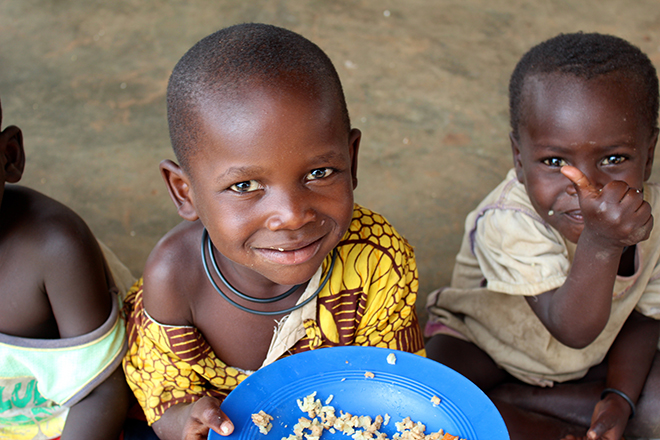Zero Hunger
What do we mean by Zero Hunger?
One of the main Sustainable Development Goals for 2030 is to reach Zero Hunger. But what does that actually mean?
he UN's definition of Zero Hunger goes beyond a single number. A more complete rundown of the second Sustainable Development Goal (SDG) is to “end hunger, achieve food security and improved nutrition, and promote sustainable agriculture.”
To measure the success of achieving this, the UN outlines five targets to indicate our progress towards Zero Hunger (more on each of these below): Access to safe, nutritious, and sufficient food year-round End malnutrition in all its forms Increase agricultural productivity Sustainable food systems and agricultural resilience Diversified crops and seeds
Why Zero Hunger matters
Simply put, we can't achieve truly sustainable development around the world if we don't end hunger and malnutrition. As much as poverty causes hunger, hunger is also a key cause - and maintainer - of poverty. If a person doesn't get enough food, they'll lack the strength and energy needed to work. Or their immune system will weaken from malnutrition and leave them more susceptible to illness that prevents them from getting to work. This can lead to a vicious cycle, especially for children. If a mother is malnourished during pregnancy, that can be passed on to her children. The costs of malnutrition may be felt over a lifetime: Adults who were stunted as children earn, on average, 22% less than those who weren't stunted. In Ethiopia, stunting contributes to GDP losses as high as 16%. Beyond that, however, we all want our families, friends, and loved ones to live long, creative, happy lives. Having enough food that provides the nutrients we need is a key ingredient. Here's how Concern is working to reach this goal across each of the five UN SDG targets.
Access to safe, nutritious, and sufficient food year-round
By 2030, the goal is to end hunger and ensure that everyone (particularly those most vulnerable) has access to safe, nutritious, and sufficient food year-round. What's key here is the issue of vulnerability. Many groups who are traditionally more susceptible to hazard and risk in an emergency - including women, infants, people living in extreme poverty, or in areas especially susceptible to the climate crisis - are those who struggle to meet their dietary requirements year-round. Regardless of the roadblocks, however, the world still produces enough food to feed its entire population. Kenya's Tana River County, for example, has borne the brunt of the country's climate-related impacts over the last few decades, leading to rising hunger levels. In 2020, Concern worked with communities in this county on an integrated agriculture and livelihoods program called the LEAF Project, which took two approaches to a common challenge: Provide lifesaving treatment for acutely-malnourished children and pregnant/lactating women, and prevent future cases of malnutrition through sustainable livelihoods that allow people living in poverty and marginalisation to generate long-term incomes. In the end, food security levels among those communities participating in LEAF rose dramatically. So much so that, for the first time in three decades, there was no need for food aid distribution in the communities where LEAF was active.
End malnutrition in all its forms
There are a few different types of malnutrition, which in and of itself is a side effect of hunger. Regardless of the specific diagnosis, each can have a lifetime of ramifications - especially for young children. Malnutrition in all its forms costs the global economy as much as €3.5 trillion, owing to human capital lost, premature mortality, increased healthcare costs, compromised school performance, and adult productivity. In 2000, Concern was part of a revolution in the treatment of malnutrition in extreme low-income communities, particularly those where other factors like conflict and remote locations posed barriers to getting medical treatment. A combination of community-based health workers and treatment through portable, shelf-stable therapeutic food has helped to save millions of lives in the last two decades.
Are we on track to achieve Zero Hunger by 2030?
The sad answer is: No. Conflict and climate change were both major barriers to ending hunger before 2019, and while there was steady progress still being made, much of it has been reversed since the rapid spread of COVID-19. In east Africa, a locust invasion that decimated crops coincided with pandemic-related shutdowns, creating a crisis as multifaceted as it is damaging. In low-income countries, small-scale food producers have been hit especially hard - and these farmers can make up as much as 85% of food producers in their region. Beyond food production, stunting and wasting among children are also likely to worsen due to the events of the last two years. We still don't know the full effects of the pandemic on child hunger, but one estimate suggests that the number of children suffering from malnutrition could increase by over 10 million between 2020 and 2022.
Zero Hunger: What can I do to help?
Addressing the current hunger crisis as well as the data-informed indicators we have around future hunger crises will be a clear test of humanity this decade. There are many solutions to world hunger. Here are some ways that you can take action and help: Eliminate food waste in your home. Food waste is one of the leading causes of hunger in the world, and one of the easiest steps you can take. Use that you purchase while it's fresh, or freeze items to extend their shelf-lives. Shop local and sustainably. Supporting your local farmers and food systems helps to make your consumption more sustainable - and often the quality of food is much better. Let your representatives know that Zero Hunger is a priority. As a constituent, your voice matters to elected officials. Ask that your TDs continue to honour foreign assistance commitments that Ireland makes towards countries. Many of these funds are earmarked for food aid and agricultural interventions that could help eliminate hunger levels in certain areas. Vote with your wallet. Supporting organisations like Concern allows us to continue our proven, value-for-money work in ending malnutrition. A one-time, tax-deductible gift of €50 can provide a full course of therapeutic food to save a child's life. A recurring, tax-deductible monthly gift of €100 can feed an entire family for the year.
